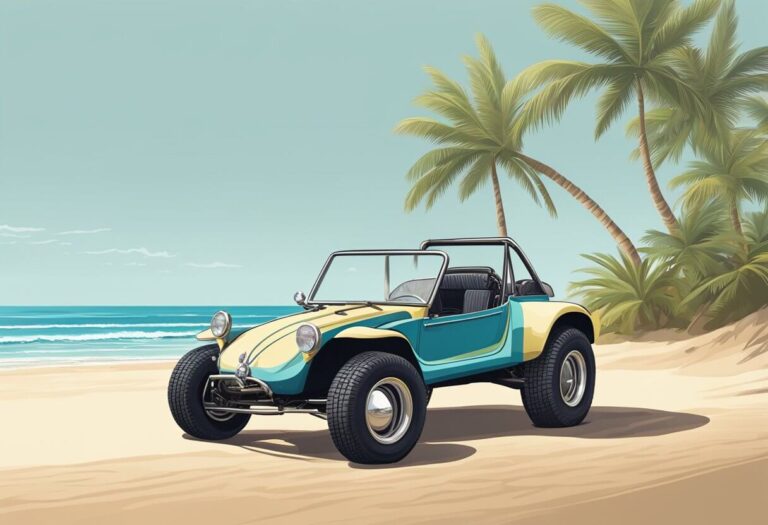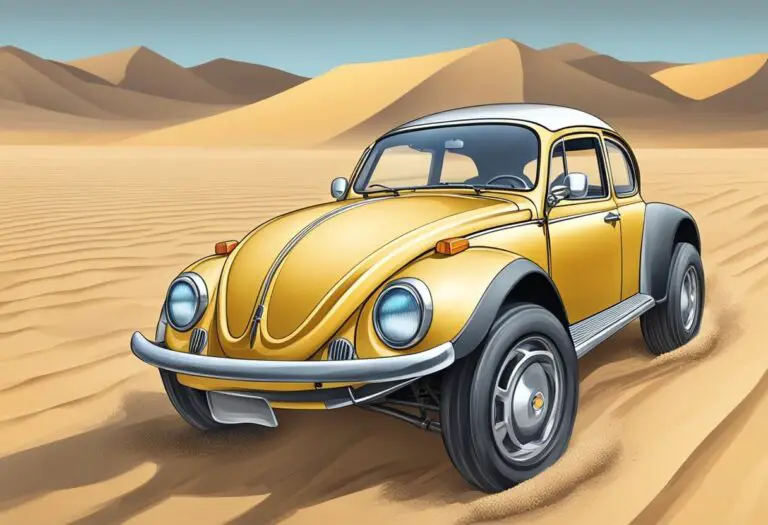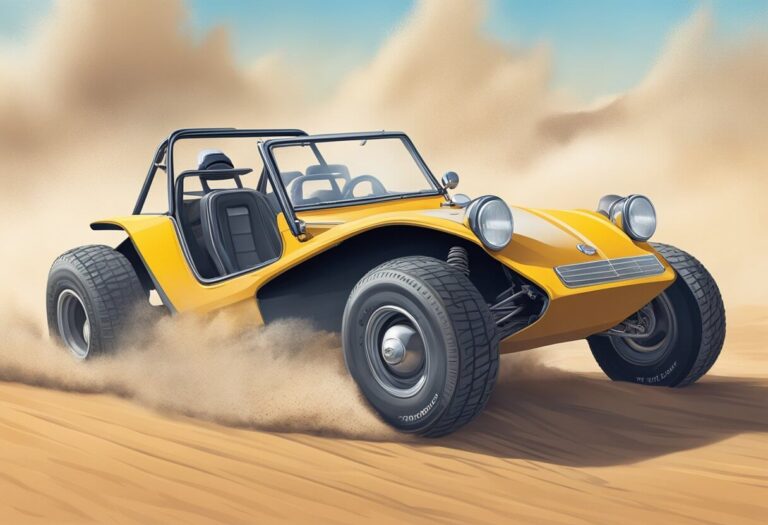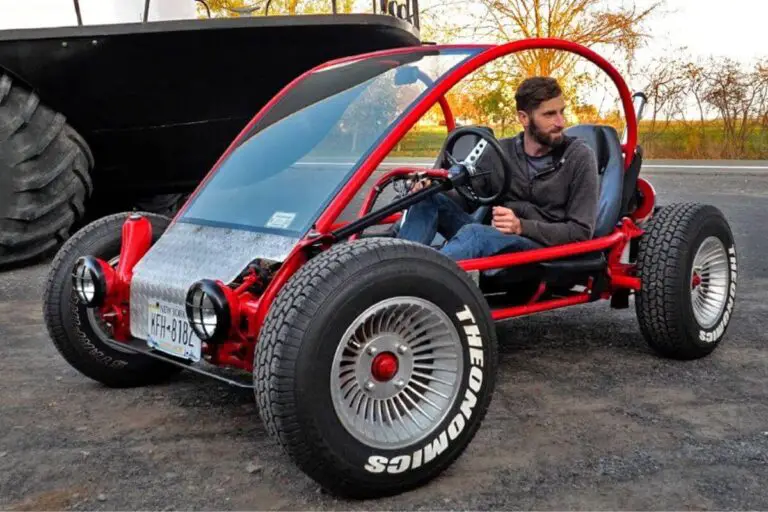Volkswagen Dune Buggy: Everything Explained!

For over 50 years, the Volkswagen dune buggy has captured imaginations with its classic open-air styling and fun-loving beach culture vibe. Who doesn’t dream of cruising down the coast or racing across sun-drenched dunes in one of these iconic rides?
But where did the dune buggy originate, and what makes it such an enduring classic? This article will explore the fascinating history, timeless minimalist design, and customization potential that have solidified the VW dune buggy’s place in automotive culture.
We’ll dig into topics like:
- The beginnings of the dune buggy craze in California
- Popular VW-based dune buggy models over the decades
- What gives the dune buggy its iconic style
- How to buy or build your dream dune buggy
- Maintaining and modifying a VW buggy
So let’s dive right in and discover why these classic beach buggies inspire such passion in drivers past and present!
A Brief History of the Volkswagen Dune Buggy
While dune buggies are now strongly associated with 1960s California beach culture, they didn’t originate there. Pre-WWII Southern California hot rodders were actually the first to create custom vehicles for high-speed desert driving. But these creations were built from salvaged Ford Model T and A parts rather than VW components.
The Meyers Manx Launches the Craze in California
The dune buggy as we know it today traces its roots back to 1964, when surfer Bruce Meyers fiberglassed a sculpted body onto a modified Volkswagen Beetle chassis to create the now-iconic Meyers Manx.
This slick, lightweight open-top buggy with swooping fenders was crafted specifically for tearing up sand dunes. Meyers initially only planned to build a few for friends. But after taking his radical design to the dunes of Pismo Beach, California, demand exploded literally overnight.
Meyers began selling complete kits through his new company, B.F. Meyers & Co. For $985, customers received a tough fiberglass body shell, shortened VW chassis parts, suspension pieces, and easy step-by-step instructions. Thousands of DIY enthusiasts jumped at the chance to build their own dune-ready buggies.
The Meyers Manx dune buggy has gone down in history as the most replicated kit car ever, with over 300,000 units sold. It singlehandedly launched the dune buggy frenzy of the 60s and 70s.
Dune Buggies Hit the Beaches
It didn’t take long for Meyers’ minimalist, lightweight buggies to become a fixture screaming along the beaches of Southern California. Their wide, balloon-like tires allowed them to cruise effortlessly over sand. An open design with short front and rear overhangs enabled excellent maneuverability on crowded beaches.
Weekend warriors and surfers alike embraced dune buggies as the epitome of casual coastal fun. They also gained popularity with off-roaders for desert driving, trail running, and relatively affordable recreational racing.
By the late 1960s, it was impossible to drive California’s iconic Highway 1 without seeing dune buggies packed with laughing, suntanned passengers. The vehicles helped cement the state’s image as a sun-soaked driver’s paradise.
Custom Builds Take Off
The runaway sales success of the Meyers Manx inspired numerous other companies to offer dune buggy kits utilizing the tried-and-true Volkswagen Beetle platform. Brands like Fiberfab, Formula Vee, and Baja Bugs gave builders even more options to create their ideal beach cruiser.
Some kits included sporty fenders and minimalist bodies, while others went to the extreme with practically no bodywork at all (also known as sand rails). The VW-based platform meant builders could easily swap engines and components to match the desired performance level. They could also customize every detail from suspension to paint.
The incredible range of builds cemented the dune buggy’s reputation as an endlessly customizable vehicle perfect for reflecting your personality. No two were ever exactly alike.
The 70s and 80s: Peak Popularity
By the 1970s, dune buggies had secured their place as icons of California’s beach lifestyle and off-road culture. On a typical summer weekend, the Golden State’s coasts, deserts, and trails swarmed with the distinctive vehicles cruising in caravans or packed with suntanned passengers.
Custom dune buggy builders pushed boundaries with ever-more-radical designs featuring bold paint jobs, powerful engine swaps, and Wild West-inspired detailing. Buggies were customized to serve as rugged Baja racers, stripped-down sand rails, and even eccentric art cars.
Popular car magazines of the era like Hot Rod and Car Craft regularly spotlighted the wildest and most innovative dune buggy customs. California in the 70s and early 80s was the golden era of Volkswagen-based buggies. To this day, vintage buggies from this peak period are prized collector’s items.
Modern Revival
While new dune buggy sales declined in the late 1980s as the VW Beetle was retired, the vehicles never disappeared from California’s coastal towns and off-road hot spots. A devoted community of enthusiasts kept vintage-buggy culture alive.
In recent years, the popularity of 1960s and 70s culture has fueled a surge of renewed interest in vintage dune buggies. Owners can now source newly fabricated OEM-quality replacement parts to restore and upgrade their classics. Some companies even offer newly constructed dune buggies closely replicating the iconic early designs.
Purists still prize vintage-original buggies, but resto-mod builds combining classic looks with modern reliability keep the vehicles relevant. The dune buggy continues to deliver endless fun to new generations seeking four-wheeled adventure.
Popular Volkswagen-Based Dune Buggy Models Through the Years
While dune buggies maintain a similar iconic profile, numerous distinctive models have emerged over the decades built upon VW Beetle underpinnings. Here are some of the most influential and sought-after buggy designs that have left their mark on dune culture.
1. The Meyers Manx
As the original dune buggy that launched an entire industry, the Meyers Manx deserves first mention. Its signature smooth, swooping fenders tapering back from the chrome headlights, bull-nosed hood, and integrated roll bar epitomize timeless dune buggy style.
The Manx’s fiberglass body contributed to its lightweight, agile feel and capability to traverse challenging dunes and trails. New Manx builds and restored vintage models are among the most coveted dune buggies today. Bruce Meyers’ iconic design remains the gold standard.
2. Baja Bugs
Baja Bugs mimicked the rugged off-road racers competing in Mexico’s grueling Baja 1000 rally through the 1970s. Extra suspension travel, heavy-duty shocks, and BFGoodrich tires mounted on wide steel rims gave them impressive all-terrain abilities.
Sturdy roll cages and skid plates protected vulnerable components from trail damage. Baja Bugs brought race-inspired customization to recreational weekend warriors. Their muscular stature and go-anywhere attitude make them ideal for desert running.
3. Formula Vee Racers
As the name implies, Formula Vee buggies were designed specifically for VW-class dirt track racing competitions of the 1960s and 70s. They married capable tube-frame chassis with high-performance VW engines, quick-ratio steering, and competition suspensions.
While less streetable than production dune buggies, Formula Vee variants remain popular with vintage racing enthusiasts who appreciate their unique history and rear-engine handling. These quick and nimble machines still carve up dirt ovals decades later.
4. Beach Buggies
In contrast to high-strung racers, Beach Buggies emphasize laidback style and leisure over hardcore performance. With an abundance of seating for passengers, festive paint schemes, and detail touches like side-mounted surfboard racks, they encapsulate the essence of coastal cruising.
Wide tires, minimalist open bodies, and smokin’ custom engines mean Beach Buggies retain plenty of power for enjoying dunes and trails. But their primary focus stays on delivering spacious, breezy fun for beach days and showing off eye-catching style.
5. Sand Rails
At the extreme end of dune buggy minimalism sit Sand Rails. As the name suggests, they’re designed to excel at high-speed runs across towering dunes. Huge paddle tires, long-travel suspensions, and powerful VW engines allow them to blast through soft sand without sinking.
The radically stripped-down tube-frame chassis and near-total lack of bodywork help keep weight low while allowing massive suspension articulation and clearance. More at home off-road than on pavement, Sand Rails offer exquisitely specialized dune performance.
What Gives the Volkswagen Dune Buggy its Iconic Style?
Over fifty years since its inception, the VW dune buggy remains instantly recognizable thanks to a few key stylistic attributes that give it an enduring visual appeal.
Classic VW Beetle Underpinnings
Sharing the same basic structure as the iconic Volkswagen Beetle two-door economy car cemented the dune buggy’s popularity. The affordable, readily available Beetle chassis presented an ideal foundation for customization that was easy for home builders to work on.
The dune buggy’s characteristic shape also mimics the curves of a Beetle’s body, lending a pleasing familiarity. Using the Beetle platform helped make VW-based dune buggies accessible to the masses.
An Open Design That Embodies Freedom
Chopping off the Beetle’s roof and doors to create an open-top two-seater perfectly suited the dune buggy for its beachy lifestyle image. The lack of weather protection provides an airy, free feeling complemented by the expansive views.
Short front and rear overhangs enhance maneuverability. Knobby off-road tires and elevated ground clearance hint that this vehicle yearns to escape paved roads. The minimalist open cockpit defines dune buggy freedom.
Customizable Style From Day One
Since the first dune buggy kits offered near-infinite customization possibilities, personalization became integral to their appeal. Creative builders can retain the familiar dune buggy silhouette while putting their own spin on every detail.
From engine choices to suspension setups, vivid paint colors, wild add-ons, and interior flourishes, VW-based buggies invite owners to tailor them exactly to their taste. Few other automobiles on the road lend themselves so perfectly to stylish customization.
Enduring Retro Charm
For many drivers, the sight of a classic dune buggy tooling down the highway still conjures up nostalgic images of 1960s California beach culture. Their distinctive retro design immediately stands out yet manages to still look artsy and contemporary.
Unlike some passing fads, the dune buggy’s evocative style has remained timeless. Each new generation discovers the joys of cruising with the sun on your shoulders and wind in your hair. The appeal of these rolling symbols of freedom will never fade.
Finding and Building Your Dream Volkswagen Dune Buggy
If you’re bitten by the dune buggy bug, several excellent paths can lead you to owning the VW-based beach cruiser you’ve always envisioned.
Buy a Fully Assembled Buggy
The most instant (but generally priciest) route to dune buggy ownership is purchasing a turnkey new or pre-owned model. Companies like Meyers Manx offer brand new bespoke buggies hand-built to your specifications for around $30,000 and up.
You can also find restored and modified vintage buggies, resto-mod builds, and extensively customized one-of-a-kind dune buggies starting around $15,000. Opting for a pre-made buggy means you can be riding the dunes or cruising the coast as soon as the purchase is complete.
Build From a DIY Kit
For a more hands-on (and affordable) option, various companies sell dune buggy kits that include key components like a fiberglass body shell, suspension and chassis parts, wheels and tires, and instructions.
Kits generally range from around $3,000 to $6,000. You’ll need to source crucial additional elements like a VW engine and transmission yourself, then complete the buggy’s assembly. While requiring more work, kits let you learn as you build and create a fully custom ride.
Start With a Donor VW Beetle
The traditional dune-buggy-builder path is to buy an older air-cooled VW Beetle or derelict body shell, then build up your ideal custom buggy from scratch around it. This approach demands solid mechanical skills but allows complete creative freedom.
Sourcing a 1960s or 70s Beetle in rough cosmetic condition but with a sound chassis and drivetrain for under $5,000 provides an ideal blank canvas. From there, you can construct or adapt a new dune buggy body and customize every component just as you envision.
Join the VW Buggy Community
Speaking of inspiration, connecting with the vibrant community of fellow dune buggy aficionados opens up a valuable wellspring of guidance, ideas, used parts sources, and hands-on help for your project. Southern California, unsurprisingly, remains a hub of air-cooled VW and dune buggy clubs and gatherings.
But thanks to the internet, online forums now let vintage Volkswagen enthusiasts share know-how worldwide. Tapping into the collective wisdom of seasoned builders through forums, clubs and in-person meetups can prove invaluable for first-timers.
Research Extensively and Set a Realistic Budget
Before wading into any dune buggy build or purchase, be sure to thoroughly research what’s involved so you know what to expect. Understand how much work each step entails, what parts are compatible or may need custom fabrication, and the costs involved.
Crunch the numbers to set minimum and maximum budgets that keep your dune buggy dreams realistic. VW-based buggies offer incredible flexibility from budget builds to luxury customs. But comprehensive planning is key to getting the style you crave at a price you can afford.
Maintaining and Modifying: Keeping Your VW Buggy Running Great
Like any classic vehicle, proper care and maintenance will keep your prized dune buggy running smoothly for years of fun. And gradual modifications allow improving these iconic rides over time.
Find a VW and Buggy Specialist Mechanic
Because dune buggies blend custom aftermarket parts with vintage VW components, finding a mechanic well-versed in both is ideal. They can properly service unique elements of your buggy while spotting issues with the classic VW engine and drivetrain pieces.
Seeking out air-cooled Volkswagen and custom buggy specialists, especially those experienced with Meyers Manx and other classics, will ensure your baby gets the expertise she deserves. You want someone who knows your vehicle inside and out.
Keep the Elements at Bay
Since dune buggies lack standard weather protection, keeping rain, dirt, sand, and moisture from penetrating the engine bay and chassis is a must. Always use a fitted rain cover when storing the buggy.
Regularly hose out the chassis to remove caked mud and grime. Clean the engine compartment at least monthly, checking for any rust or water ingress. Prevention now means fewer problems down the road.
Upgrade Over Time
One of the joys of owning a dune buggy is gradually enhancing performance, ride quality, or convenience. As budget allows, components like hydraulic disc brakes, modern coilover shock absorbers, fuel injection conversions, and LED lighting deliver major improvements over original equipment.
Don’t attempt to do everything at once. Space out upgrades over years to spread out costs. Over time, you can evolve and optimize your buggy without sacrificing the classic charm.
Address Issues Quickly
Like any older vehicle, dune buggies can be prone to oil leaks, balky electrics, and general wear and tear over the decades. Don’t delay addressing problems—resolve them promptly before bigger issues arise.
Keep up with tune-ups and maintenance, and immediately diagnose any new vibrations, noises or malfunctions. Catching problems early maximizes your beach buggy fun time.
Modify With Care
Resist the urge to bolt on every high-performance part available right away. Radical engine swaps or heavy suspension and wheel/tire combos can potentially overload the chassis and drivetrain.
Mod judiciously to enhance your VW’s abilities and make the car your own, but understand how each modification impacts other components and the overall driving experience. Seek experienced advice to ensure mods improve your dune buggy rather than compromise it.
Still Turning Heads After All These Years
More than half a century since roaring to life on the beaches of Southern California, the Volkswagen dune buggy remains an automotive icon synonymous with freedom, fun in the sun, and ready adventure. With its roots in DIY car culture and inspired iconic design, the buggy perfectly captures surfer cool.
New generations continue to fall for the dune buggy’s timeless minimalist shape, the visceral thrill of open-air driving, and the endless potential for customization. Whether cruising empty coast roads, packed with friends en route to the beach, or tackling off-road trails, these classic VW-based buggies deliver grins for miles.
Despite newer competitors, the dune buggy remains unmatched for style and pop culture appeal. Drivers worldwide keep the joy of air-cooled VW beach buggies alive through meticulous restorations, badass custom builds, and many more years of fun in the sun. Their appeal simply never goes out of fashion.
So for your own four-wheeled taste of the California dream, embrace the timeless fun and freedom of the legendary Volkswagen dune buggy.
Dune Buggy Variants for Every Style
While the iconic Meyers Manx started it all, today’s dune buggy scene encompasses a diverse range of creative designs and styles. Builders can choose a model that perfectly suits their priorities and personality.
Classic Beetle Conversions
The purist’s choice transforms a vintage air-cooled Beetle into a dune buggy while maintaining as many OEM parts as possible. Buzzing around in a slammed and chopped Beetle shell delivers serious old-school style points.
Baja Racers
Inspired by high-speed desert competition, Baja buggies feature race-ready chassis, beefed-up suspensions, rugged tires, and snarling engines. They let you feel like a trophy truck racer while trail riding.
Street & Strip Customs
Custom builders seeking the best of both worlds opt for streetable dune buggies with registered VINs, license plates, and 2-3 seat configurations. But they still pack upgraded engines, modern amenities, and race-inspired style.
Electric Conversions
Purists may scoff, but electric motor swaps deliver a totally modern dune buggy experience. Insane torque and near-silent operation let you focus on nature. Just be ready to recharge after about 100 miles.
Modern Replicas
Companies like Meyers Manx now sell new fiberglass bodies with modern tube-frame chassis that recreate the classic look. They combine retro fun with 21st century tech like fuel injection and disc brakes.
DIY Specials
Building a dune buggy from scratch around a VW pan lets creative types make something totally unique. This approach demands skill and research, but the payoff is a one-of-a-kind ride.
No matter your preferences and vision, the versatile dune buggy platform means you can create exactly the vehicle you’ve always fantasized about owning.
The Art of Building or Modifying Your Perfect Dune Buggy
Assembling your fantasy dune buggy involves equal parts research, planning, skill, and creative vision. Use these tips for a dream build:
Start with the chassis – A solid chassis matched to your intended use forms the foundation. Then design everything around it.
Gather reference images – Study various designs and styles that appeal to you. Create a vision board of your perfect buggy to guide the project.
Nail down specs and details – Decide on critical specs like chassis type, suspension setup, wheel/tire size, engine and drivetrain components.
Make a master build list – Create a comprehensive list of every single part and system you’ll need so nothing gets forgotten.
Allow ample time – Building a fully custom buggy will take hundreds of hours. Make sure your timeline is realistic to avoid frustration.
Set a firm budget – From parts and tools to paint and finishing, building costs add up fast. Stick religiously to your budget to avoid wasting money.
Start small and work upwards – Begin with chassis mockups before constructing. Once the chassis is complete, move to drivetrain, etc.
Check fitment constantly – Test fit all components regularly to catch any clearance or compatibility issues immediately.
Go Slowly and Double-check – Meticulously check each system as you build for proper assembly, tight fasteners, and quality welds. Don’t rush!
Building your dream dune buggy is a labor of love. Invest the necessary research and patience, and eventually you’ll end up with a hands-on masterpiece you can enjoy for years.
Sources for Vintage and New Dune Buggies
Looking to buy a pre-built dune buggy? Here are some top sources to discover your perfect beach-bound cruiser:
Meyers Manx – The OG dune buggy maker offers brand new hand-built beauties to your custom specs. Expect premium fit and finish.
Early California VW – This professional SoCal shop builds killer air-cooled VW dune buggies from the 60s style you crave to modern tube-frame beasts.
Fiberfab – Along with replica bodies, Fiberfab sells whole custom-built buggies channeling their classic 1970s models. Quality and style for days.
Rogue Status Motors – Custom engineering and fabrication allow for one-of-a-kind resto-mod builds of VW buggies and other classics.
VW Classic Buggy Supply – This comprehensive online parts retailer also sells completed vintage-inspired dune buggies at affordable prices.
TheSamba Classifieds – The vintage VW community’s most popular forum features dune buggies and parts for sale regularly.
Local Listings and Auctions – Don’t overlook local classifieds, Craigslist, Facebook Marketplace, auctions, and estate sales for leads on projects.
With demand for vintage-inspired beach buggies surging, lots of reputable sources can help connect you with your perfect summer cruiser before hitting the dunes.
Modernizing a Classic Dune Buggy While Retaining Character
Upgrading a vintage dune buggy without losing its retro charm is an art form. Use these tips:
- Favor period-correct looking parts like chrome or polished aluminum over out-of-place modern components
- Choose a subtle, era-appropriate color palette and avoid wild graphics that feel too modern
- Retain patina on original steel and aluminum parts when possible to maintain aged charm
- Research exhaust systems that provide a mellow retro sound rather than loud, raspy tones
- Upgrade brakes and suspension for safety and handling but keep lift heights modest
- LED bulbs can modernize lighting discretely when chosen with appropriate chrome housings
- Add Bluetooth/satellite radio for convenience but mount the head unit out of immediate sight
- Source reproduction seats, steering wheels, shifters, and pedals that look vintage but feel fresh
- Powder-coat faded chroming rather than replacing with plastic parts to retain quality
With careful selection of upgrade parts, you can gain reliability while maintaining the comforting character of a well-aged beach cruiser. Invest time to find the sweet spot between vintage style and modern drivability. Your timeless dune buggy will reward you with grins for years to come.
The Bottom Lines
Even as automotive trends come and go, the Volkswagen-based dune buggy remains an enduring symbol of fun, freedom, and the endless summer. For over 50 years, these classic open-top buggies have delivered thrills and smiles across beaches, dunes, trails, and roads worldwide.
The dune buggy owes its lasting popularity to its sporty minimalist shape, friendly character, DIY builder roots, and infectious sense of joy. For many, just seeing a vintage VW buggy bouncing down the road conjures nostalgia and younger days of cruising under sunny skies.
Fortunately, a new generation of dune buggy lovers continues to keep the air-cooled VW spirit alive. Meticulous restorations preserve aging examples for future generations. Bold custom builds put creative new spins on the classic formula. And improved reproduction parts make it easier than ever to build or modernize your dream machine.
The dune buggy has cemented its place as an automotive icon reflecting the endless summer vibe. As long as free spirits thirst for four-wheeled fun, these beloved VW classics will keep bringing smiles everywhere adventures are found. Their appeal and charm is simply timeless.
So for your own taste of dune buggy magic, join the friendly, far-flung community in celebrating and preserving these rolling symbols of the Southern California dream. The sun-filled spirit of the VW beach buggy is yours to experience.






